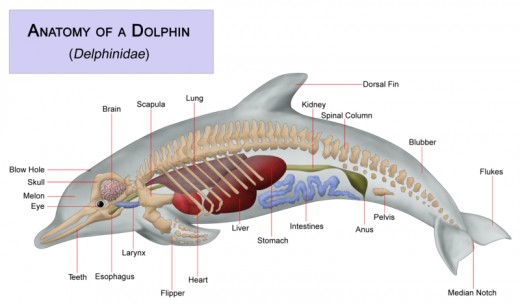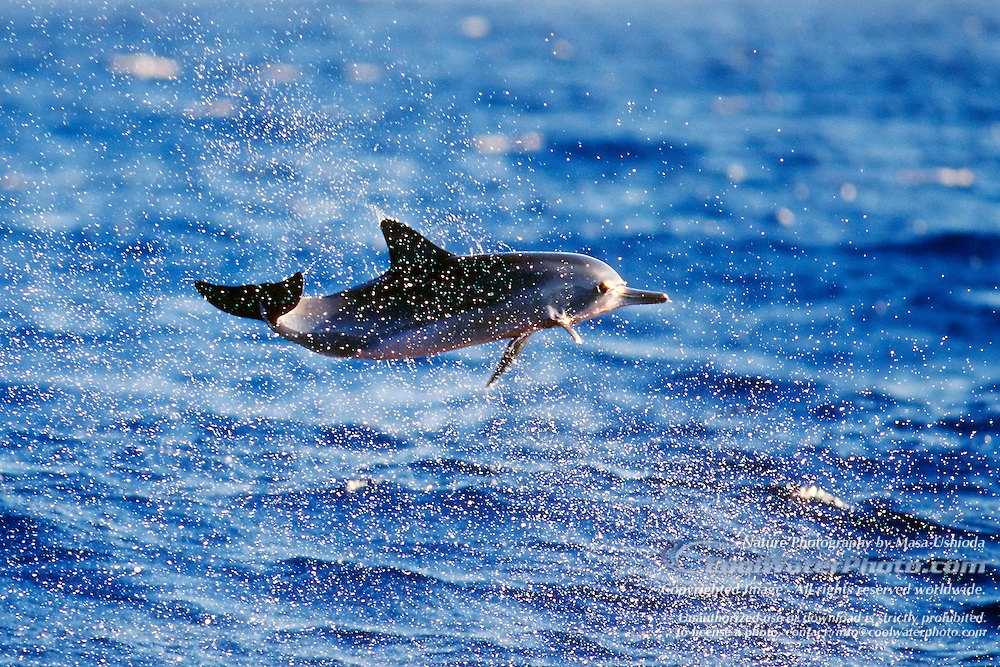SWIMMING
Have you ever asked the question how do fins make you swim faster? You'd probably tell me, Laurin duh. It moves more water than fingers or toes do. Exactly. Fins are able to push more water out of the way, thus moving faster.
However, dolphins can outspeed humans in water for a number of reasons. One, they live in the water and thus have more experience and are MEANT to swim. Humans can swim but it isn't necessary for our survival.
Two, you know how I said they were meant for swimming? Well dolphins are built with a sleeker shape that helps the water guide over their bodies. As you may have noticed, humans have less aerodynamics going for them when they are sideways or more realistically, have diagonal surface area.
 (slightly modified but taken from http://www.windycooler.com/blog/swimming)
(slightly modified but taken from http://www.windycooler.com/blog/swimming)
As you may have known, having more surface area for anything slows you down when pushing against a substance.

It's like having the picture above. Where the left picture is obviously facing more resistance to its current path and thus will have a slower velocity.
Not only does shape matter in swimming and the surface area of your body against the water, but also friction. Maybe you'd think, friction? What'd friction have to do with swimming? Friction should be the same on a dolphin as it is on everything.
Not quite. Olympic swimmers (or most competitive swimmers) shave as much body hair as possible because it increases friction in the water, which in turn slows you down. Just saying, never seen much hair on dolphins.
While we're talking about it, dolphin skin is so smooth compared to ours right? So it probably has a drag-reducing effect which helps them swim so fast! Scientists thought so too and this theory was called Gray's Paradox.

(Digital Particle Image Velocimetry (DPIV) is used to track and measure the water flow around Primo, a retired U.S. Navy bottlenose dolphin. Rensselaer Polytechnic Institute Professor Timothy Wei used this and other technology to solve the 70-year-old scientific mystery of "Gray's Paradox." https://www.youtube.com/watch?v=yFlf1lqYQHw)
A British zoologist named James Gray observed dolphins and concluded from his studies that dolphins just didn't have the muscle power to be able to swim so fast and overcome enough drag. He believed the solution had to be in their skin, because their skin is so smooth.
However, more recent scientific studies have shown that it isn't the dolphins skin that makes the huge difference but by blowing bubbles in waters where the dolphins were swimming, the scientists could see just how powerful their dolphin tails were.
So the dolphins' secret? They are designed to have speed from their streamlined body to their powerful tail muscles.
Have you ever asked the question how do fins make you swim faster? You'd probably tell me, Laurin duh. It moves more water than fingers or toes do. Exactly. Fins are able to push more water out of the way, thus moving faster.
However, dolphins can outspeed humans in water for a number of reasons. One, they live in the water and thus have more experience and are MEANT to swim. Humans can swim but it isn't necessary for our survival.
Two, you know how I said they were meant for swimming? Well dolphins are built with a sleeker shape that helps the water guide over their bodies. As you may have noticed, humans have less aerodynamics going for them when they are sideways or more realistically, have diagonal surface area.
 (slightly modified but taken from http://www.windycooler.com/blog/swimming)
(slightly modified but taken from http://www.windycooler.com/blog/swimming)As you may have known, having more surface area for anything slows you down when pushing against a substance.

It's like having the picture above. Where the left picture is obviously facing more resistance to its current path and thus will have a slower velocity.
Not only does shape matter in swimming and the surface area of your body against the water, but also friction. Maybe you'd think, friction? What'd friction have to do with swimming? Friction should be the same on a dolphin as it is on everything.
Not quite. Olympic swimmers (or most competitive swimmers) shave as much body hair as possible because it increases friction in the water, which in turn slows you down. Just saying, never seen much hair on dolphins.
While we're talking about it, dolphin skin is so smooth compared to ours right? So it probably has a drag-reducing effect which helps them swim so fast! Scientists thought so too and this theory was called Gray's Paradox.

(Digital Particle Image Velocimetry (DPIV) is used to track and measure the water flow around Primo, a retired U.S. Navy bottlenose dolphin. Rensselaer Polytechnic Institute Professor Timothy Wei used this and other technology to solve the 70-year-old scientific mystery of "Gray's Paradox." https://www.youtube.com/watch?v=yFlf1lqYQHw)
A British zoologist named James Gray observed dolphins and concluded from his studies that dolphins just didn't have the muscle power to be able to swim so fast and overcome enough drag. He believed the solution had to be in their skin, because their skin is so smooth.
However, more recent scientific studies have shown that it isn't the dolphins skin that makes the huge difference but by blowing bubbles in waters where the dolphins were swimming, the scientists could see just how powerful their dolphin tails were.
So the dolphins' secret? They are designed to have speed from their streamlined body to their powerful tail muscles.
SSH
Here are some fun
links here on the bottom. If you want to know more about
dolphins click on the links. (Or if you want to see some
more awesome dolphin photos for that matter.)






